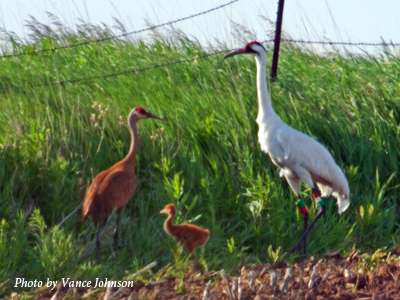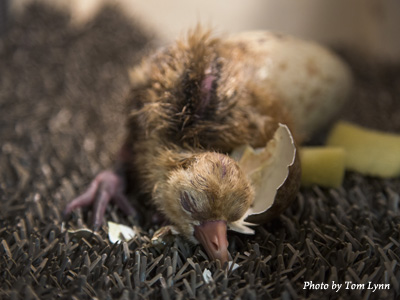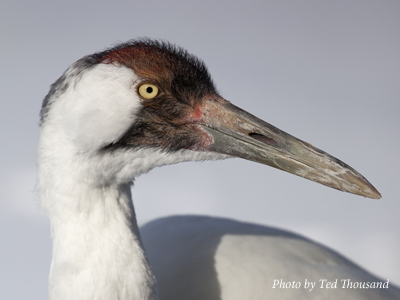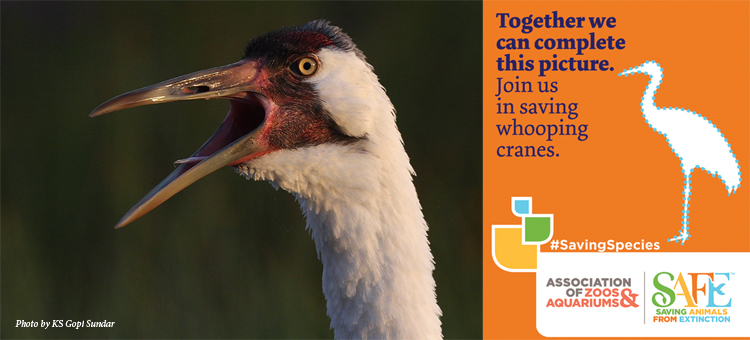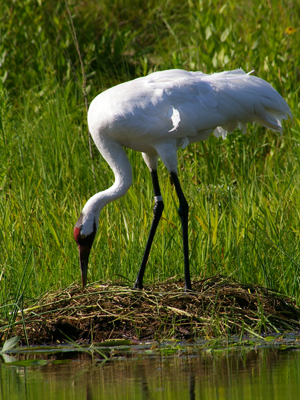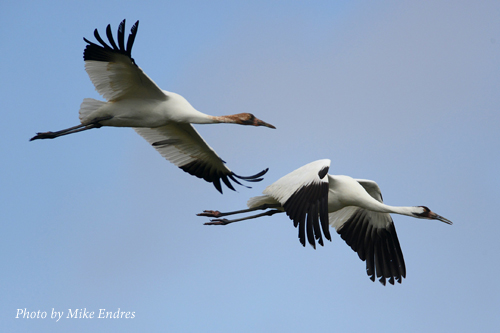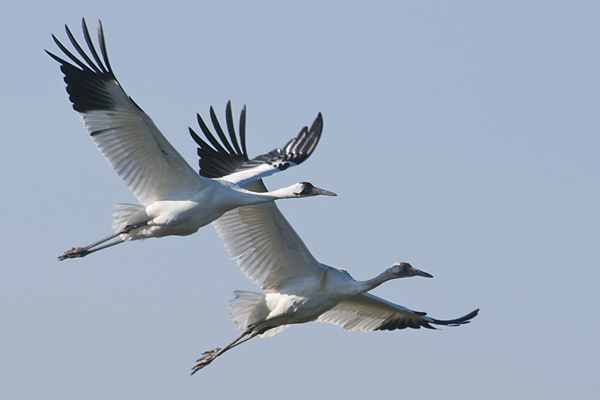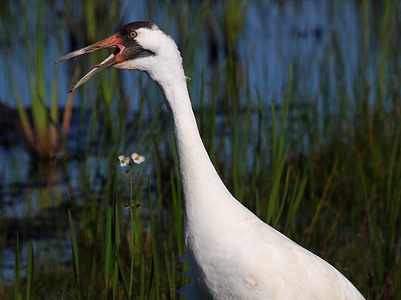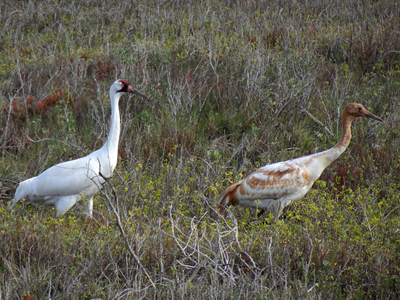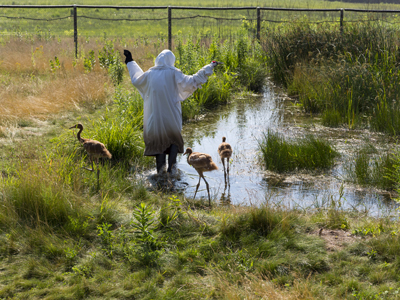 Crane chicks always cause a bit of a stir, but one in particular is making waves among Wisconsinites near its home in the Horicon National Wildlife Refuge and with craniacs everywhere. Affectionately named “Whoopsie,” the chick is a hybrid of a male Whooping Crane and a female Sandhill Crane. With all the excitement around this unusual mix comes much curiosity. Read on for answers to your most pressing “Whoophill” questions!
Crane chicks always cause a bit of a stir, but one in particular is making waves among Wisconsinites near its home in the Horicon National Wildlife Refuge and with craniacs everywhere. Affectionately named “Whoopsie,” the chick is a hybrid of a male Whooping Crane and a female Sandhill Crane. With all the excitement around this unusual mix comes much curiosity. Read on for answers to your most pressing “Whoophill” questions!
Category: Whooping Crane
Endangered Whooping Crane Hatches!
 The International Crane Foundation has announced this spring’s first hatch of a Whooping Crane chick at its headquarters in Baraboo, Wisconsin. As a federally designated endangered species, the hatch of a Whooping Crane is always a significant event. The fact that it was hatched through a captive breeding program for release into the wild is further evidence of how critical such programs are to the species’ survival.
The International Crane Foundation has announced this spring’s first hatch of a Whooping Crane chick at its headquarters in Baraboo, Wisconsin. As a federally designated endangered species, the hatch of a Whooping Crane is always a significant event. The fact that it was hatched through a captive breeding program for release into the wild is further evidence of how critical such programs are to the species’ survival.
The Unfinished Story of the Whooping Crane
 Whooping Cranes have never faced more threats. Click here to support our work to conserve this beloved bird.
Whooping Cranes have never faced more threats. Click here to support our work to conserve this beloved bird.
Endangered Species “Vanishing” from the International Crane Foundation
 In observance of the tenth anniversary of Endangered Species Day, Whooping Cranes will “vanish” from their exhibits at the International Crane Foundation. Their implied disappearance is meant to highlight the growing need to save endangered species from extinction.
In observance of the tenth anniversary of Endangered Species Day, Whooping Cranes will “vanish” from their exhibits at the International Crane Foundation. Their implied disappearance is meant to highlight the growing need to save endangered species from extinction.
Saving Whooping Cranes One Egg at a Time

We stole 15 Whooping Crane eggs. But don’t worry! It’s all part of a science-based strategy to increase the number of Whooping Cranes above their current world population of just 600 birds. And, so far, the results are looking good.
Whooping Cranes V
 In 2009, 23 Whooping Cranes (nearly 10% of the world’s population) died when their fresh water source was diverted along the coast of Texas. Today, Jim Blackburn, the attorney fighting on behalf of the Whooping Cranes, shared this touching original poem with our team. Now we share it with you and wish you a very happy Earth Day!
In 2009, 23 Whooping Cranes (nearly 10% of the world’s population) died when their fresh water source was diverted along the coast of Texas. Today, Jim Blackburn, the attorney fighting on behalf of the Whooping Cranes, shared this touching original poem with our team. Now we share it with you and wish you a very happy Earth Day!
Suspected Shooting of a Whooping Crane in Aransas Bay, Texas
 Only two weeks after the announcement of a tragic Whooping Crane shooting in Louisiana this fall, the U.S. Fish & Wildlife Service and Texas Parks & Wildlife Department (TPWD) have announced the recent death of a Whooping Crane in Texas, also due to a shooting.
Only two weeks after the announcement of a tragic Whooping Crane shooting in Louisiana this fall, the U.S. Fish & Wildlife Service and Texas Parks & Wildlife Department (TPWD) have announced the recent death of a Whooping Crane in Texas, also due to a shooting.
Endangered Whooping Crane Shot in Louisiana
 On Wednesday, the Louisiana Department of Wildlife and Fisheries announced the illegal shooting of a Whooping Crane in Vermilion Parish, Louisiana – along with an award of up to $10,000 for information on this crime.
On Wednesday, the Louisiana Department of Wildlife and Fisheries announced the illegal shooting of a Whooping Crane in Vermilion Parish, Louisiana – along with an award of up to $10,000 for information on this crime.
Appeals Court Denies Request to Reconsider Whooping Crane Ruling in Texas
 The Fifth Circuit Court of Appeals has declined The Aransas Project’s (TAP) request to re-consider the Court’s June decision to overturn a 2013 ruling by U.S. District Court Judge Janis Jack, which concluded that Whooping Cranes, as an Endangered species, should be considered when decisions are made about water removal from the Guadalupe and San Antonio rivers that nourish coastal Texas Whooping Crane habitat.
The Fifth Circuit Court of Appeals has declined The Aransas Project’s (TAP) request to re-consider the Court’s June decision to overturn a 2013 ruling by U.S. District Court Judge Janis Jack, which concluded that Whooping Cranes, as an Endangered species, should be considered when decisions are made about water removal from the Guadalupe and San Antonio rivers that nourish coastal Texas Whooping Crane habitat.
Louisiana Welcomes ICF Whooping Cranes
 The four Whooping Crane chicks reared at ICF this year are in Louisiana! The chicks, along with ten additional Whooping Crane chicks hatched at the Patuxent Wildlife Research Center in Maryland, had jet service to Louisiana today thanks to the Windway Capital Corporation.
The four Whooping Crane chicks reared at ICF this year are in Louisiana! The chicks, along with ten additional Whooping Crane chicks hatched at the Patuxent Wildlife Research Center in Maryland, had jet service to Louisiana today thanks to the Windway Capital Corporation.

